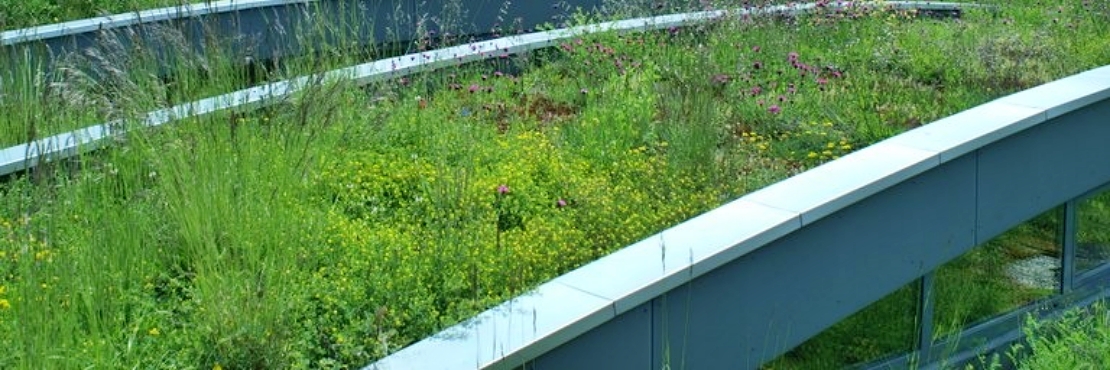Sophie Dickinson of TimeOut writes:
On top of every flat roof in Basel – new and old – you’ll soon find a thriving wildflower garden. For the past decade or so, the inner city has made it a requirement that all houses, offices and other buildings cover empty roof space with biodiverse greenery. All that natural insulation means lower energy bills, and the scheme has also made rare birds a more frequent sight throughout the city.
One way to lower energy costs, reduce flooding and improve biodiversity? Cover every new building in plants
The scale of the project is unbelievable, with the green-roof mandate playing a large part in there now being five square metres of green space per inhabitant – the highest amount in any city, anywhere in the world. And while the gardens are all undeniably beautiful to look at (and make for a thoroughly pleasant place to live), there are plenty of other perks.
Great article about Basel, Switzerland and how its greenroof policy drove uptake, but what Sophie Dickinson may not know is, it was Basel that drove the London green roofs policy. I flew to Basel in 2000 to meet with Stephan Brenneisen and brought back his approach.
Dusty Gedge,
President of the European Federation of Green Roof and Wall Associations
The environmental benefits of the scheme are huge. All that rooftop shrubbery stores a heck of a lot of carbon, slashing the city’s net emissions. Biodiversity – extremely difficult to maintain in a modern city – also appears to be flourishing. Almost 80 species of beetle have been spotted, along with 40 types of spider (many of them endangered). The gardens also provide refuge for 175 plant species, including nine kinds of orchid. And, as flash floods increasingly threaten the lives of city-dwellers, the soil can reduce water run-off by up to 20 percent. So the gardens aren’t just an attractive architectural feature – they’re a vital part of the city’s climate policy.
Locals are also big fans, partly because energy bills are massively reduced. During winter the leafy layer acts as insulation, trapping the heat inside, and in summer the temperature can be around five degrees lower. These benefits are obviously attractive, but it took legal action for the gardens to really take off across the city. Regulations dictate that new buildings have to have the roof forests installed, and whenever structural changes and checks take place on older properties, owners have to retrofit them with gardens too.
There’s a historical precedent in Basel for these green roofs. In the 1970s a city hospital built a rooftop garden to improve experience for patients. And way back in 1914, a water plant in nearby Zurich experimented with planted roofs to cool down the building. Researchers drew on these early ideas for their own plans, scaling them up for the whole of Basel.
They were led by Stephan Brenneisen, head of research at the urban ecology unit of Zurich University. He is keen to emphasise that cities can’t just grow a garden on a roof and think they’re making an impact. The substrate needs to be a certain depth – at least 12cm, and ideally 15cm – and the greenery should be native to the area. In Basel, regulations require a particular Swiss wildflower seed mix, which is sometimes even specified to a certain region.
You can read more about green roofs in Basel in this case study “Green roofs in Basel, Switzerland: combining mitigation and adaptation measures,” by Stephan Brenneisen and Nathalie Baumann of the Zurich University of Applied Sciences Wädenswil.
Watch the Greenroofs & Walls of the World Virtual Summit 2015 Video: “Biodiversity in the Sky – How Green Roofs Can Be Designed as Wild Life Refuges” Keynote by Stephan Brenneisen.
Interestingly, the main problem scientists are now facing when it comes to green roofs isn’t disgruntled city officials or disinterested residents. It’s from their sustainable rooftop sibling, the solar panel. ‘At first, we basically had a good solution for unused space,’ says Brenneisen. No one was using the rooftops, so the installation of a garden wasn’t too disruptive. ‘Nowadays, though, the solar discussion isn’t easy to solve.’ The rooftops could be used for something else that is arguably even better for the environment. Brenneisen says his team is figuring out a way to allow the two climate solutions to coexist.
Watch the Greenroofs & Walls of the World Virtual Summit 2015 Video: “Biosolar Roofs” by Nathalie Baumann and Dusty Gedge.
Brenneisen is confident that an environmental revolution within cities is possible. ‘Societies are willing to change,’ he says. And while it took a hefty law change to drive through his scheme, perhaps other cities will see Basel’s roofs and think, simply: we could do with a bit of that.
Read more: How Basel started a green-roof revolution in Europe
 Greenroofs.comConnecting the Planet + Living Architecture
Greenroofs.comConnecting the Planet + Living Architecture









How Basel, Switzerland Jumpstarted a Green Roof Revolution in Europe – Greenroofs.com | NEWS EUROPE
[…] Source link : https://www.greenroofs.com/2021/11/10/how-basel-switzerland-jumpstarted-a-green-roof-r… Author : Publish date : 2021-11-10 17:18:18 Copyright for syndicated content belongs to the linked Source. Tags: BaselEuropeGreenGreenroofscomJumpstartedrevolutionRoofSwitzerland ADVERTISEMENT Previous Post […]
How Basel, Switzerland Jumpstarted a Green Roof Revolution in Europe – getproduct
[…] Full Source link Get Here […]